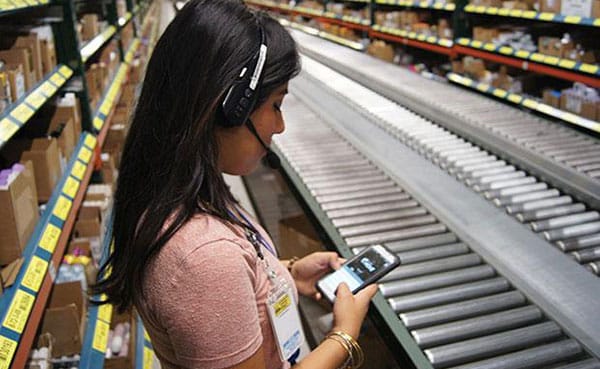Walmart Establishes Multi-Channel Fulfillment Centers to Prepare for the Holidays
A cornerstone of Walmart’s ecommerce strategy has been to create ecom fulfillment facilities separate from its traditional regional DCs that serve it’s 11,500 stores. It has also significantly expanded local fulfillment capacity utilizing stores for local pick up and delivery, especially for groceries. But the anticipated surge in ecommerce shopping this holiday season has made Walmart adjust their broader multi-channel distribution strategy.
According to an article in the Wall Street Journal, Walmart is placing “pop-up” ecommerce fulfillment centers inside 42 of their regional distribution centers. These ecom pop ups will fulfill 30% of Walmart’s online holiday orders. In effect, it is greatly expanding ecom fulfillment capacity without building any new fulfillment centers. According to a Walmart spokesperson quoted in the Journal article, the key is in the technology because “It’s faster and more cost-effective to build code than it is to build and permit a building.”
In addition to meeting expanded ecommerce demand, Walmart’s motivation in utilizing the regional distribution centers is to position products closer to consumers in hopes to reduce transportation costs. The pop up sites will ship ecommerce orders to stores on the same trucks that carry pallets of products to re-stock the store store shelves. The ecommerce products can then be shipped to local customers from the store.
It isn’t clear from the news reports whether Walmart is creating physically distinct ecommerce areas within the regional DCs, or if they are merging ecom and store picking. Simultaneously picking ecom and replen orders is more complex since that requires adapting the current picking process for different order types. It would also require a different order release strategy. This is one of the big challenges of multi-channel DC operations. Learn how Conair combined their multi-channel distribution processes in one facility by watching our virtual warehouse tour on-demand.
Preparing For a Record-Breaking Returns Season
Returned items are one of the largest headaches for retailers, and this year the headache has gotten bigger due to the increase in online purchases of big, bulky merchandise like furniture, appliances, and exercise equipment. GoTRG, a reverse-logistics specialist, reported that the size of units returned to retailers like Walmart and Lowe’s has increased by over 200%. Additionally, one home-improvement retailer doubled the number of truckloads of returned items per week because of the size of the items returned.
Companies are setting up regional return centers in order to manage increased returns and an increase in the size of returned items, but this only helps them manage and organize inventory. Next the companies will have to optimize the large items returns processes with an eye to getting the returned items shipped out to new customers. See how one Lucas customer created a productive, accurate and flexible returns process that prioritized picking returned items.
Pfizer and Moderna Set To Distribute over 70 Million Covid Vaccine’s By 2021
The two frontrunners in the Covid-19 vaccine, Pfizer and Moderna are set to distribute a combined 70 million Covid vaccinations before the end of 2020. Both vaccines have seen over a 90% success rate in their initial studies and await the FDA sign off. However, the challenge of distribution is still up in the air.
Moderna claims to have an advantage in distribution due to the nature of their vaccination. According to reports, Moderna’s vaccine can stay stable at 2-8° Celsius, whereas Pfizer’s requires minus 80° Celsius. Fortunately, Pfizer has designed temperature-controlled boxes that use dry ice to keep the vaccines stored at the required temperature for 10 days. In addition to temperature requirements, Pfizer opted to bypass McKesson (government chosen distributor) while Moderna did not. According to McKesson CEO, Brian Tyler, “Ultra-frozen vaccines, which are those requiring temperatures of minus 60 degree Celsius or colder are not within the scope of McKesson’s contract with the CDC.”
Pfizer is working with DHL, UPS and FedEx to build cold storage facilities, airplane and truck fleets and freezer farms to successfully distribute Covid vaccines around the world. There is high confidence in the ability to handle distribution, but with a shortage of reefer transportation and a fully constructed logistics infrastructure there are many challenges still to be overcome.
Machine Learning Will Make Warehouse Managers More Productive
Many DC managers rely on their own experience and judgements – and often, their superior Excel skills – to estimate how many workers they will need to pick, pack and ship their next day or next week’s projected order volumes. Some have the benefit of a Labor Management System that uses engineered labor standards to take some of the guesswork out of the plan. ELS-based systems use pre-defined models of processes, a limited number of variables, and pre-determined or recorded average time values to estimate how many labor hours will be needed to pick a given volume of orders.
But most ELS systems don’t adjust to the impacts of seasonal labor, order surges, or changes in order or product mix, so managers are left to interpret the data they have and adjust to avoid being under-staffed. Many planners have learned to hedge their bets. Labor planning is one of the leading warehouse optimization challenge that lends itself well to Machine Learning.
Machine Learning is a form of AI in which learning algorithms are applied to large sets of data to create predictive models relating to specific business outcomes. Popular machine learning techniques include deep learning and deep neural networks – when you hear those terms, think “machine learning.”
For DCs that rely on supervisors and managers to make staffing decisions with imperfect information and no defined models, Machine Learning systems can help them make better, more accurate plans without resorting to off-line tools like Excel. And for DCs with ELS, Machine learning provides a more dynamic alternative for predicting labor requirements especially in larger, more complex DCs and in times of change. For DCs that have dedicated staff maintaining complex engineered labor standards systems, machine learning will free time for managers and engineers to focus on process improvement and optimization strategies.
To learn more about the advantages of machine learning for warehouse management, check out our recent blog, Machine Learning Will Make Warehouse Managers More Productive.





